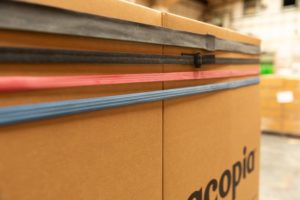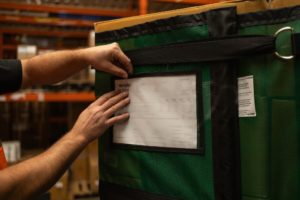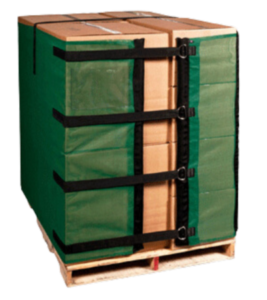Since the 1970’s, pallet wrap has been the reliable packaging product for most warehouse operations. As sustainability goals tighten, along with associated rising costs (The Plastic Packaging Tax) of using packaging products with single use plastics, many logistics leaders are re-thinking their reliance on traditional pallet wrap.
The good news? With the right strategy and right products, it’s entirely possible to eliminate pallet wrap from your warehouse operations while maintaining load stability and improving efficiencies.
Why remove pallet wrap from the warehouse?
Traditional stretch film can create challenges for modern warehouses. Beyond the obvious environmental concerns, using pallet wrap does generate recurring costs through material purchases, disposal fees and recycling costs, and labour time. Many operations can struggle with film waste, inconsistent application, and the physical demands placed on workers during some hand wrapping processes, especially without the right support and supplier partnerships. These hidden and not so hidden costs can quickly add up.
How to move towards reducing and removing pallet wrap
1. Step 1 – calculate your use
Your first step to approaching a different way to wrap pallets for storage and in transit is to understand how much you’re using in your warehouse.
- Are you wrapping by hand or by machine? If you’re wrapping high volumes and in one location in your warehouse, using a pallet wrap machine will provide greater wrap consistency meaning you will use less plastic compared to hand wrapping pallets.
- Have you got the right pallet wrap machine? High volume users will set up operations with Power Stretch machines as this is an integral tool to achieving plastic and time savings.
- Consider switching from standard pallet wrap to pre-stretched to reduce the volume of plastic on every pallet wrapped
- Analyse wrapping tensions and wrapping techniques used to wrap pallets – both on machines and for manual hand wrapping. Look for support and training if required to enable further plastic reduction
- Are there any further opportunities to downgauge the film being used on certain inventory?
- Look for examples where the complete roll of wrap is not being used and why rolls are being discarded
You supplier should automatically offer this type of audit or “health check” with training to ensure that you’re always getting value for money from your wrap use and reducing your single use plastics, constantly working towards Best Practice.
Once you’re confident that you’ve reduced your wrap usage as much as possible, you can now consider alternative load containment products.
2. Step 2 – transition suitable loads
Examine your current load types and identify which products could transition to alternative securing methods. Internal movements and short-distance shipments are often the easiest starting points.
- Think about your supply chain, will any changes cause issues for them?
- Start to pilot suitable alternative products to identify issues early on
- Identify any training needed with these new products or methods
Again, your supplier will work with you to identify these suitable loads, helping you to reduce risk during storage and transport.
3. Step 3 – switch to reusables for load stability
Reusable pallet wrap products have become extremely popular when it comes to reliable, cost effective and sustainable pallet management and movement, helping to eliminate single use plastic and speeding up pallet through-put.
Reusable Pallet Bands and Straps

Heavy-duty elastic bands and adjustable straps offer excellent load containment without single-use materials. iReuse Pallet Bands are perfect for different load sizes and can be reused hundreds of times, dramatically reducing per-pallet costs over time. They are available in different thicknesses and stretch capabilities depending on the weight and size of the load.
Made from natural rubber, eco-friendly Pallet Bands can be used for 3-5 years. No expensive equipment required, application can be achieved in seconds and training in a matter of minutes.
A return on investment is typically achieved after just 12 uses making it one of the most cost-effective ways to store and move pallets.
It’s also an ergonomic solution with minimal, if any, bending and stretching required when securing pallets with bands.
Reusable Pallet Jackets, Wraps and Covers
If you’re serious about getting rid of plastic wrap from your warehouse, this product is definitely one to be considered and trialled. Tough and durable, iReuse Pallet Jackets can be used thousands of times and have a life span, depending on the type of jacket, of up to 5 years.
Available in different sizes depending on your pallet heights, these jackets offer different opportunities for users such as customisation with branding, reducing pallet wrapping times to just 30 seconds with minimal training, and providing easy visibility of pallet load contents for quick goods inspections.
Pallet jackets are able to withstand demanding environments including freezer and cold storage conditions allowing food manufacturers, for example, to take hot food through to cooling and then to the freezers in much less time as heat can escape much faster compared to pallet wrap. This reduces production times by up to 50%. Imagine the cost savings!
When it comes to operational payoff, typically users would see payback in just a few months compared to the significant long-term investment in pallet wrap machines and the on-going replenishment costs for both machine wrap and hand pallet wrap.
Both Pallet Bands and Pallet Jackets offer a real and reliable solution to achieving sustainable stock movement and environmentally friendly product storage.
Will Reusables work for every load?

Realistically, no. Fragile, high-end valuable goods, or export loads may still require pallet wrap for compliance with external transport regulations. Reusables also work best with uniform pallets, not those with irregular shapes. However, if even 50% of internal or stable outbound loads can be transitioned to wrap-free alternatives, the environmental and financial savings can be huge.
How to measure the success of reusable pallet wrap
Key metrics to watch throughout your transition to reusables:
- Cost savings
- Waste reduction
- Labour efficiency
- Product damage rates
The Path Forward with Reusables
Eliminating pallet wrap from your warehouse is entirely achievable with the right combination of alternative securing methods, smart packaging design, and strategic implementation. The key is starting with a clear assessment of your current needs and gradually transitioning to sustainable alternatives that maintain or improve load security.
The benefits extend far beyond cost savings. You’ll reduce environmental impact, improve workplace conditions, and often discover operational efficiencies you hadn’t anticipated. In an increasingly sustainability-focused market, eliminating pallet wrap positions your warehouse as a forward-thinking operation ready for the future of logistics.

